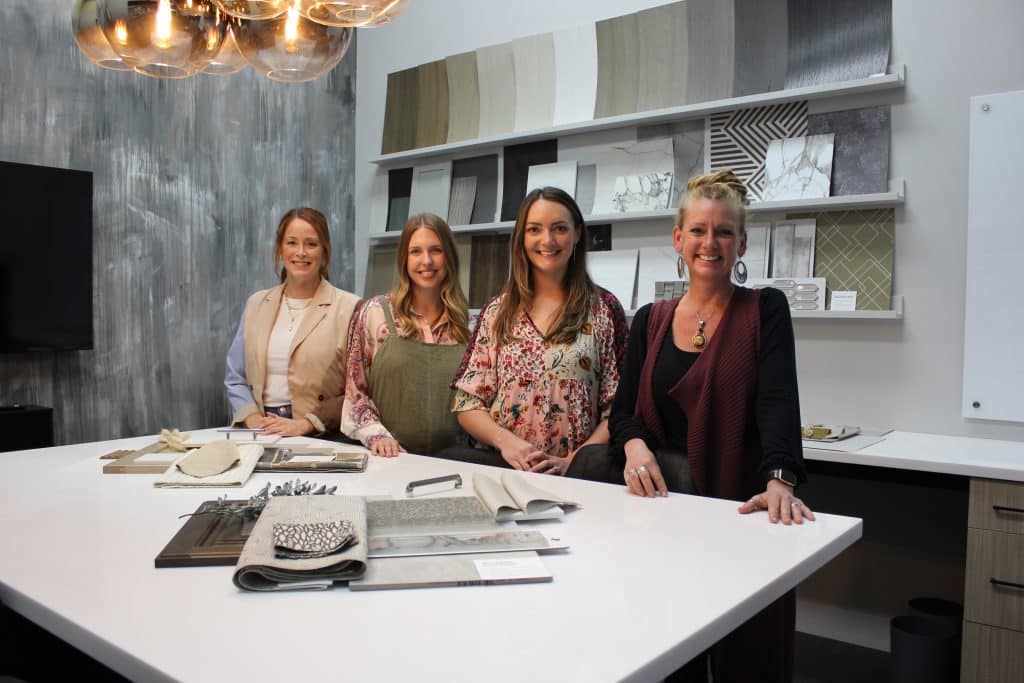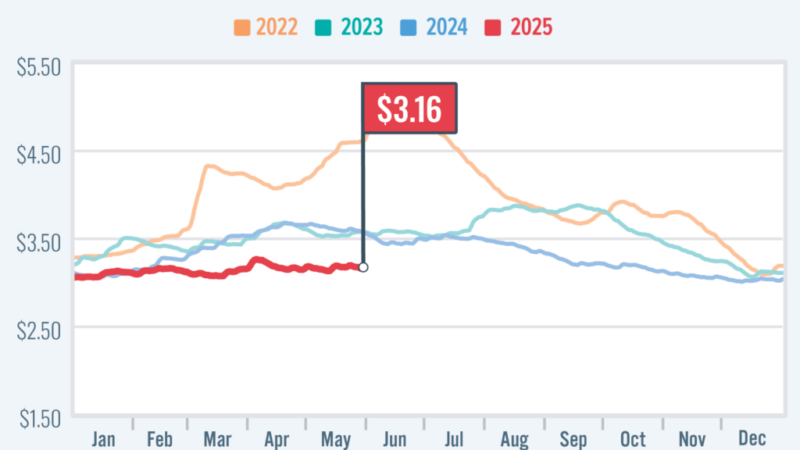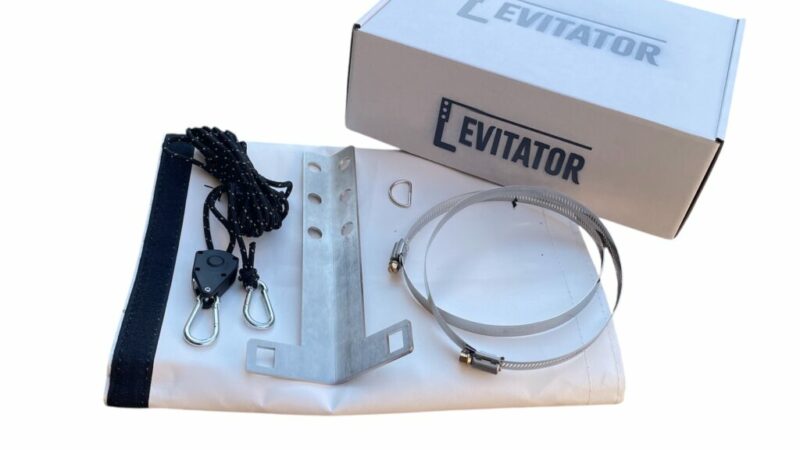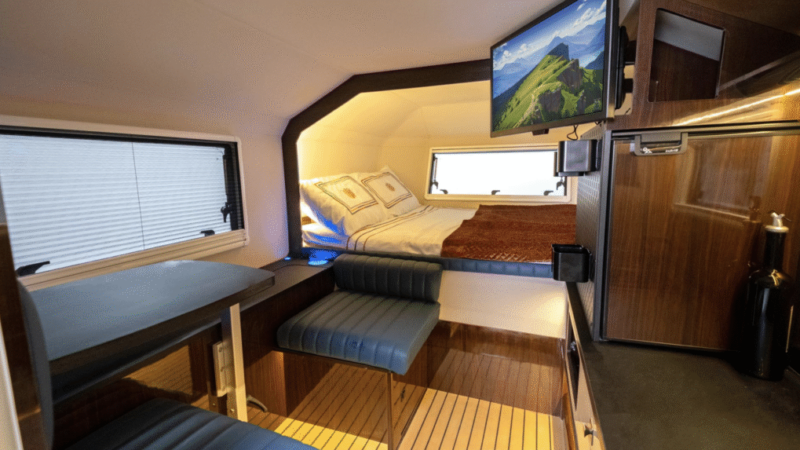Patrick Interior Designers Target Today’s Educated Consumers

The design team at Patrick Industries includes, from left: Senior Designer Corey Payne, Designer & Graphic Artist Kaitlyn Kirkwood, Designer Cassie Russell and Vice President of Design Sarah Williams.
To the design team at Patrick Industries, the interior design of an RV is just as important as any other part of the unit. Without a warm and inviting interior décor, the RV won’t capture the attention of a consumer at the onset, and it won’t hold the interest over the long haul either.

Sarah Williams
“When you’re shopping for anything, you want it to feel comfortable, like home,” said Sarah Williams, vice president of design at Patrick Industries. “When you’re shopping for your home, you pay attention to all kinds of details.
“And – even more so now with all of the HGTV television shows – people know terminology that they didn’t know 15 years ago,” she continued. “So, they know the difference between different types of countertops and different types of flooring. The end consumer is a lot more knowledgeable now.
“I think the diversity in the design has really changed that, too,” she added. “It’s not just walk into an RV and they all look the same. There’s a huge variety of styles and colors and design and floorplans.”
Williams – who was joined by her design team that included Senior Designer Corey Payne, Designer & Graphic Artist Kaitlyn Kirkwood and Designer Cassie Russell – was speaking from Patrick’s expansive Design Studio.
The large building on the southeast side of Elkhart, Ind., successfully offers visitors a sampling of the company’s 80-plus business units for the RV, marine and manufactured housing industries. As it is, with the assistance of the Patrick design team, an OEM product manager or interior designer is sure to find a cohesive, well-intentioned look for any RV line or brand.
As far as current design trends, Williams and her team are seeing a bit of a transition from the grays and whites that have dominated the RV interior décor as of late.
Although while that color palette was a welcome change from the browns from years ago, the grays and whites in some cases were often labeled as a sterile office rather than a warm and inviting RV interior.
“It’s a lot brighter than things used to be a long time ago. We finally brightened them up and introduced those grays – it took this industry a little longer to get there compared to residential – but then it got very light, almost a clinical, bright white,” said Williams. “And now we’re going a little bit warmer, not as dark as things used to be, but in general, a mix of warm and cool. We’re kind of baby stepping towards that, but definitely starting to see some warmer colors.”
For example, Williams pointed to a wall of assembled vignettes comprised of flooring samples, cabinetry doors, wallboard samples, hardware and other accessories. Each vignette, while including some shades of grays and whites in its mix, also expertly brought in earth tone colors such as browns and various shades of mossy greens, navy blues and dark reds.

Corey Payne
“So, instead of seeing this palette that is all gray or all white, or all cool tones, but we now have more of a mixture. We kind of went and from gray to very natural, and now we’re seeing more of those mid-tone or richer colors coming in also,” Payne said.
“We’ve got some green and some blue representation, too,” pointed out Kirkwood. “People are a little more kind to inviting color into the designs, too, as an accent, which has been nice and gives a different personality.”
And it goes beyond the warming color palette, Williams mentioned.
“We also are seeing different materials, or if the materials aren’t available or not conducive for RV construction, we’re saying those things emulated in different way,” she said. “We might have a paper that looks like a rattan grass, but it’s just paper. Our suppliers have gotten really good at making certain materials look like other things.”
Williams and her team mentioned that, as much as they must be aesthetically pleasing, materials all must be RV friendly, too, meaning they must be durable, lightweight, cost-effective and easily installed on a production line.
Interior Design as a Process-Driven Strategy
Regardless of a client’s budget, the Patrick design team was confident they can create a design that will satisfy the goal of creating a visually appealing look that will make a fast first impression.

Kaitlyn Kirkwood
“The very first step is getting to know your customer and the type of product they’re building,” Kirkwood explained. “Then we can make decisions like what materials are we using? Are we doing a pressed countertop versus a solid surface? There are different price points, and then also there’s who their audience is. What is their demographic? Are they catering to the Boomers or are they catering to the other generations like Millennials and GenXers?”
Picking up on that designing-for-different-demographics theme, Russell said the target buyer is one of the first criteria that needs to be established.
“I do think that, ever since the pandemic, it has challenged the industry to design for more than one generation,” she said. “So, more Millennials are purchasing units, especially with small kids in the family. For me, the unit that I would buy with three kids versus what my parents would buy is going to be a lot different because I’m going to use the unit a lot differently.
“I know that gets more into the floorplan, but it’s also getting into the aesthetic,” Russell continued. “My style is probably going to be a little bit different than my parents who are Boomers.”
Payne said the design process is different for every client, and even different for the same client each time they come to the Studio.
“I’ll say, if the customer does not have their own designer, like in-house designer, they require a lot more from us. And if they have an in-house designer, a lot of times we’re just working with them on getting samples, showing them new products,” she said.
“But every customer’s different. We could be putting together a whole package like this. We could just be pulling wall vinyl one day, cabinetry one day. It’s different every day. Just like today, I was at a customer’s office assisting them with something. So not only do they come in here and look at all the offerings here, but sometimes we are onsite assisting with a prototype.”
Picking up on that sentiment, Williams said there’s a lot of variables in the design process.
“A lot of times if we could put together a whole decor for them, but then you’ve got this fabric that they’ve committed to and they still have a ton of it that they have to use up,” she said. “So, then all of a sudden that has to be incorporated into the design. So, there are times we have to be miracle workers.”

Cassie Russell
“It’s kind of fun, though. It’s a challenge,” said Payne.
Another challenge, Williams added, was the tendency for the OEMs to “borrow” designs they see used by competitors. Payne offered shiplap as an example that has been copied by others to the point where it’s past its prime.
“They might see something that somebody’s doing and it’s successful, so they want to do very similar if not the exact same, and that’s no fun,” Williams said. “We want to do it with something different. So, we really try to have as much variety in the industry as we have power over.”
Payne acknowledged that OEMs feel a but of pressure to not stray too far from what might be considered safe, but “I do think people have branched out a lot and want to be different from each other.”
“Instead of just seeing something at a show and saying, ‘I want that, too.’ It’s like, ‘Oh, someone else is doing this. Well, I need to do it different,’” Payne offered. “We push for that, too, seeing what everybody else is doing but doing it a little bit differently.”
Still, as Kirkwood pointed out, if you wait long enough previous trends do seem to make a comeback.
“It is funny how things do make a resurgence when there are certain design choices that do date something, but then they always find a way to come back into popularity,” Kirkwood said. “Even with the browns, when I first started four years ago, it didn’t seem like anyone could imagine a chocolate interior. But now people are interested in those wood tones again. So, it’s just funny how we always come back to it and try to keep things fresh and relevant.”
Source: https://rvbusiness.com/patrick-interior-designers-target-todays-educated-consumers/







